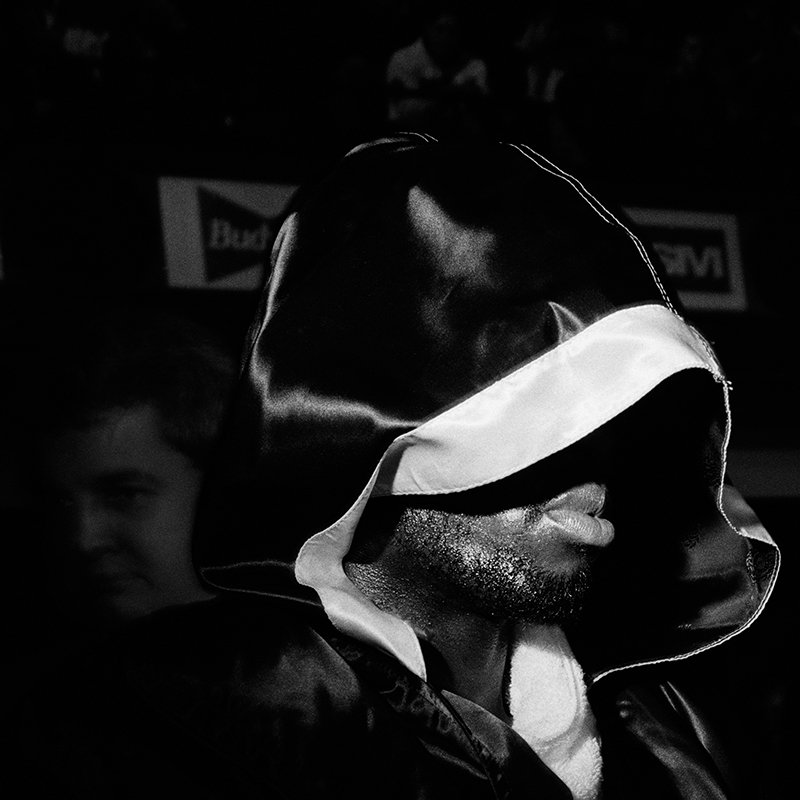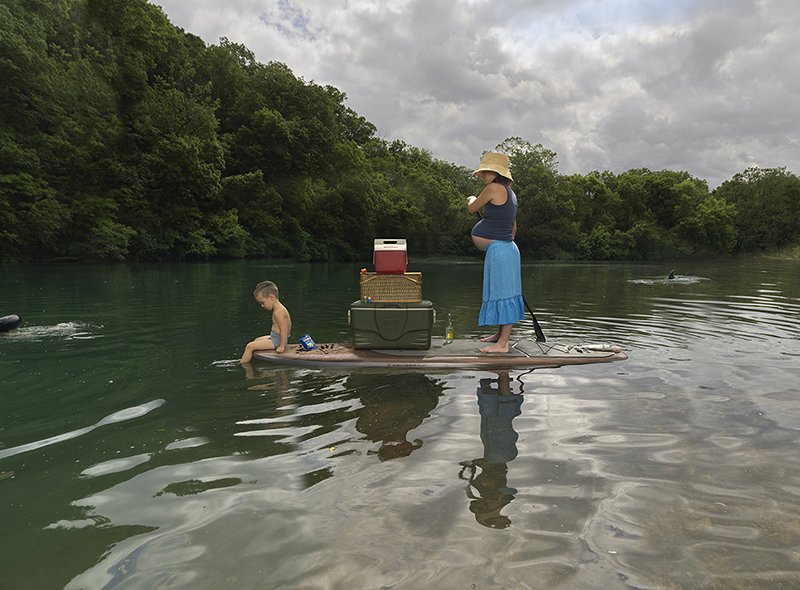Larry Fink: The Time It Takes
by Gaia Squarci
On the occasion of his retrospective at Robert Mann Gallery in New York City, the legendary Larry Fink reflects on his photographic career and the values that inspired it.

by Gaia Squarci
On the occasion of his retrospective at Robert Mann Gallery in New York City, the legendary Larry Fink reflects on his photographic career and the values that inspired it.

by Jane Henderson
The littlest of Julie Blackmon’s subjects seem trapped in a giant bubble.
Older kids, meanwhile, dangle feet in a backyard pool in a nostalgic scene of summer freedom. Further scrutiny, though, shows a chef’s knife stabbed in a watermelon and a swimmer floating face down. Is he looking for a penny, testing his lung capacity or in trouble? No adult is in sight.

by Jesse Dorris
In a 2011 interview with the now-defunct Visura Magazine, Larry Fink recalled the approach to life recommended by his mother, a one-time Marxist. “Why sublimate your need for elegance and joy and class and style and fun…I am going to live my life as fully as possible.”
Fink has sought that fullness throughout his long and varied career. As a teenager, he left his family on Long Island and arrived in the Village, where he studied with Lisette Model. He photographed Amiri Baraka and others, whom he called “delusional revolutionaries,” and travelled cross-country with them. Eventually, he settled into life on a working farm in Pennsylvania, home base for his work as a photographer for Vanity Fair, the New York Times, and GQ, to name just a few of the many publications who have published his photographs. He’s won countless photography awards for images that focused on everyone from soigné high society elites to Pacific Northwest loggers. One relative constant has been his use of a hand-held flash, a spotlight to direct the eye. Another is his compassion, hardly solemn but impossible to miss.

Robert Mann Gallery is pleased to announce the representation of Larry Fink along with his inaugural exhibition at the gallery, opening on December 7th. The show will feature works from the series: Social Graces, Boxing, and Loggers among others. Born in Brooklyn in 1941 and raised in New York City, Fink began making pictures in his early teens. He was privately taught and mentored by photographer Lisette Model whose work greatly influenced Fink. He was strongly influenced by the dichotomy within his family, and in particular, the contradictory nature of his mother—who he has described as a bourgeois woman and a Marxist.

JTF (just the facts): A total of 8 color photographs, framed in white and matted, and hung against white walls in the single room gallery space. All of the works are archival pigment prints, made in 2021 or 2022. The prints are available in three sizes – roughly 26×32, 36×47, and 45×60 inches – and come in editions of 7 or 10. (Installation shots below.)
Comments/Context: In the past two decades, Julie Blackmon has built an enviable photographic career out of deliberately pushing scenes of American domesticity into the realm of warmly recognizable fantasy. At first glance, her pictures of backyards, summer nights, modest neighborhoods, and kids running free seem altogether familiar, with the rhythms of the often chaotic everyday lives of families and children frozen for just an instant. But up close, Blackmon’s compositions reveal themselves to be meticulously controlled constructions, engaging facsimiles of reality where every single detail has been carefully placed and stage-managed to generate a desired effect. In a sense, Blackmon has used the flexibility of contemporary photography to transform images back into something like hyper-real paintings, using the mechanism of the camera to capture all the controlled elements of a given scene, but pre-visualizing and arranging them with an eye for very specific compositional choices and outcomes.

The artist’s work addresses future climate crises while attempting to make the urban environment a better place to live right now.
In the summer of 2009, the artist Mary Mattingly moved out of her New York apartment and onto a barge for a five-month experiment in off-grid urban living. With salvaged-wood cabins; a geodesic dome; a garden sprouting lettuce, squash, berries and corn; a rainwater filtration system; and solar panels that (at least on sunny days) produced enough power for brief hot showers, “Waterpod” was both a floating sculpture and a mostly self-sufficient community. Mattingly, who celebrated her 31st birthday onboard, rarely stepped ashore. She shared the space with four chickens and a rotating cast of friends, who also lived aboard the vessel. The 100-foot-long, 30-foot-wide barge floated around the New York waterways, docking for two-week stints at public piers across the five boroughs. A tugboat brought it from place to place, but the rest of the power aboard the craft came from the sun and a jury-rigged stationary bike.

Robert Mann Gallery presents Typologies, an online presentation of works by Jeff Brouws.
Practicing what the artist terms “visual anthropology,” Brouws, over the past thirty years, has persistently pursued a body of work that examines the evolving American landscape through its myriad cultural and industrial artifacts. Taking inspiration from the “anonymous sculpture” studies of Hilla and Bernd Becher, the New Topographics Movement, the deadpan artist books of Ed Ruscha—and with these latest series the topographic surveys of the 19th Century—Brouws has produced visual archives focused mainly on architectural and landscape forms that forge his own photographic territory. Without romanticizing his subject matter, the photographs ask us to consider the historic, economic or social forces that have shaped our built environment—from its initial development to its eventual demise to its rebirth.

Julie Blackmon grew up in Springfield, Mo., a city of 165,000 people in the southern part of the state, and went to college there. She got married in Springfield and raised three children there. For much of that time, her home city struck her as “this generic town with a generic name, in the middle of the country, in the middle of nowhere,” she said. And then, about 20 years ago, she picked up a camera.
“All of a sudden I’m driving by Starbucks, and the guy that served me coffee every day is outside smoking a cigarette,” said Ms. Blackmon, whose third book of photographs, “Midwest Materials,” was published this month. “I remember thinking, ‘He’s got the most beautiful cheekbones when he inhales.’ He looked right out of a Balthus painting.”

For her third monograph, Midwest Materials, Julie Blackmon has created a new body of work that sparkles with the wit, dark humor, and irony for which the artist has gained such renown. Finding insight and inspiration in the seeming monotony of her “generic American hometown,” Blackmon constructs a captivating, fictitious world that is both playful and menacing. “I think of myself as a visual artist working in the medium of photography,” Blackmon notes, “and my assignment is to chart the fever dreams of American life.” Midwest Materials follows on the sold out titles Domestic Vacations (Radius Books, 2008) and Homegrown (Radius Books, 2014).

Robert Mann Gallery considers all the artists they work with family, and some actually are. Robert Mann Gallery presents their summer exhibition, Friends + Family. This exhibition features works by artists connected not only through the gallery that exhibits their work, but also through the strong ties built between artists sharing a craft. Many artists or thereafter their estates have been with Mann since the 1980’s. After 40 years this is certainly family!
Appointments for private presentations can be scheduled in advance. Please contact us by email or phone.
Robert Mann Gallery is committed to making this website available to as many people as possible and is engaged in continued efforts to ensure that this website is accessible to those with special needs, including those with visual, hearing, cognitive and motor impairments. Our efforts in that regard are ongoing. Many internet users can find websites difficult to use. We recognize that this is an important issue, and we are working to ensure that this website is accessible to all persons who wish to use it. Our efforts to improve this website in this regard are in process, so if you come across a page or feature you find inaccessible or difficult to use, please send your feedback to: mail@robertmann.com.